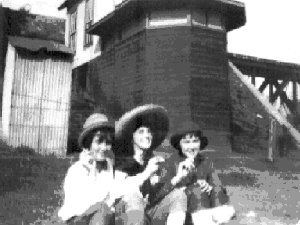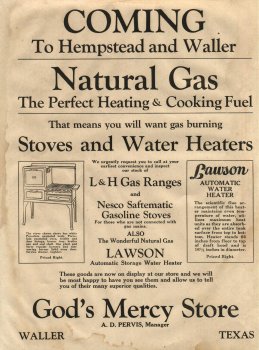SOCIALS AND ENTERTAINMENT IN PINE ISLAND

One of the more popular social events, of the time, was visiting friends and kinfolks. The whole family would load into the wagon or later the car or truck and go to visit uncle John's or aunt Kate's family just to talk and enjoy each others company. It wasn't at all uncommon, especially in the earlier "horse and wagon" days, to put pallets on the floor for the children and spend a night or two on such a visit.
Visiting was popular enough around the turn of the century that people overcame many obstacles that most current day persons with modern automobiles and highways would not consider trying.
Lucille (Milam) Daut remembers going with her friend Lena Barnett, Lena's father Joe Barnett and the rest of Joe's family to visit Joe's father. They all loaded into Joe's truck one morning and headed toward Chappell Hill. When they reached the Brazos river the water level was so high that the ferry wasn't running. Not allowing mother nature to halt a visit, Joe hired a man with a rowboat to row the whole family across the river in two trips. Once across the river, Joe used the phone at a nearby store to call his father in Chappell Hill. His father drove down to the river, loaded the whole group into his car and they continued the journey. After they spent the day visiting, "grandpa" loaded them all back in the car and drove them to the river. There, they were rowed back across the river and loaded into Joe's truck for the drive home.
Most of the area's citizens were very religious God fearing people and their social life often consisted of singings and bible study held at each others homes and at the church. Even attending the official church services or prayer meetings was also a semi-social event, although most members would have been very upset to hear it called that.
Church services allowed the members to meet before and after the service to exchange the neighborhood news events of the past week. It gave the women a chance to let the other ladies see their new dresses or sunbonnets that came far and few between. It allowed the men a chance to meet with their neighbors and discuss the crops, or the weather, or the new horse that one of them had bought.
The church also gave the people a place to join together and share their grief at funerals and after natural disasters as well as their joy at weddings and christenings.
Maybe once a month or so, if the young people were lucky, they could talk one of their families into giving a "Play Party" for the teens and young adults. The parties were usually given by Mrs. Lula and Mr. Sam Crowhurst, Mrs. Maggie and Mr. Robert Feagen, Mrs. Ellie and Henry Urquhart, Mrs. Annie and Mr. Luther Taylor or Mrs. Quilla and Mr. Lee Garrett.
Lucille (Milam) Daut has a postcard written to her by her mother (Mamie Milam), dated October 11, 1929. It states, "Lula (Crowhurst) is giving a party tonight. Baby (Chalista Milam) is going, I think Buddy (Frankie Lee Milam) is going to take her."
The word "party" had a slightly different definition in those days. It usually meant that the furniture would be moved out of a room and chairs would be placed around the walls for the guests. Sometime cake or cookies were served, but usually the only refreshment offered was a cold drink of water, fresh from the well.
At the party the young people would play "party games" such as Snap where a boy and girl would hold each others hands high up like an arch and name a boy to start the game. He would call a girl's name and she would chase him around the couple. When she caught him, he had to replace the boy holding hands. Then the girl called a boy's name and he chased her around the couple and on and on.
Some of the other "Ring Party Games" that were very popular, were actually square dances, but of course no one dared call them dances in those days, so they were party games. Tommie Garrett was the most popular "caller" for the square dance type games during the 1920's. Some of the ring games of the day were called "Black Them Boots and Make Them Shine", "Build My House, Wilburn", "Same Old Two and Go Right Through", "Four In The Middle", "Dusty Miller" and "In And Out The Window".
The older men would sometime play dominoes, shoot the moon or forty two or even a hot game of checkers. And, of course there was horseshoe pitching. Card games were out of the question for most families however, as they were "Tools of the devil" that were used for gambling and therefore sinful.
Of course In Pine Island like anywhere in the south, the men and older boys always had a hunting rifle or shotgun handy to add wild game and foul to the table. And, the whole family could enjoy fishing in the nearby creeks and stock "tanks" (small lakes.)
Beside the small creeks such as Three Mile Creek and the stock tanks(small lakes), Clear Creek on the old Houston highway gave the young people of Pine Island a place to fish, swim and picnic. Even young people living in Hempstead hiked out to Clear Creek for an afternoon of fun. Someone even installed a diving board on the west bank near the pump station.
There was a two story pump station building with the lower floor on the creek bank and the upper floor beside the railroad track. Water was pumped from the creek to fill the water tanks of the old steam engine trains.
Besides being a place of fun for the teens the creek was also a source of problems when hard rains hit the area. High school student occasionally had to spend the night with their friends in Hempstead because high water over the bridge kept them from returning to Pine Island after school.
Occasionally some of the neighbors would get out the old hand cranked ice cream freezers and have an ice cream supper at the school or someone's home. At these events the young people would play the same games that they did at the play parties.
The schools were sometime used for events such as plays or special holiday programs that were presented by the students.
Even going to town on Saturdays for supplies was often made into a social event. The farmers could compare their problems and successes with the farmers from the other communities while they ate a nickels worth of crackers and a nickel piece of summer sausage or cheese in front of the stores at noon. Some of the more popular stores were God's Mercy store in Waller and W. W. Chapman's or A. O. Burnett's store in Hempstead.
God's Mercy Store was owned and operated by Mr. Albert D. Purvis. Although not actually located in Pine Island, it was (in the author's opinion) unique enough to deserve a mention here. It's story is best told by an advertisement that appeared in the 1926 Community Fair book published by the Waller Chamber of Commerce.
GOD'S MERCY STORE Waller, Texas
God's Mercy Store, the one great store of it's kind in the world, where you have the privilege to set the profit on the goods you buy. All goods are sold at cost, nothing added as profit or gain to the store. Any percent you add to your purchase will be received with many thanks. The great store of general merchandise was not established by the righteousness of man, but by the spirit of Christ which is Love, Mercy, and Self denial.Come and see. A. D. Purvis A Servant of God
"The love of money is the root of all evil." I Timothy 6:10
=-=-=-=-=-=-=-=-=-=-=-=-=-=-=-=-=-=-=-=-=-=-=-=-=
